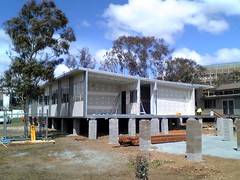Modular highrise apartment buildings
The Melbourne building is provisionally named "Little Hero apartments" and is at 16-34 Russell Place (architect Fender Katsalidis). While one of the claimed benefits of the UB system is increased height over the shipping container building limit of six floors, the Melbourne building is eight floors high.
A hybrid system could prove useful for combined commercial/residential buildings, as well as student accommodation. This would use traditional construction techniques or specialised modules for the ground and lower commercial floors of a building and then shipping container modules for the apartments above. This would allow for an eight story building.
This would be equally useful for commercial/residential and a university buildings. Commercial retail spaces as well as teaching and catering in a student building would be difficult to accommodate in the small shipping shipping container sized modules.
The current move from teaching in large purpose designed lecture theatres to "blended" teaching using the Internet and small groups could provide particularly useful for modular buildings. The student accommodation in six floors could be located above dual purpose rooms on the lower floors. These rooms would provide teaching spaces as well as entertainment, with the same computer and video education being used for instruction and entertainment.
Labels: Architecture, modular building, student accommodation





